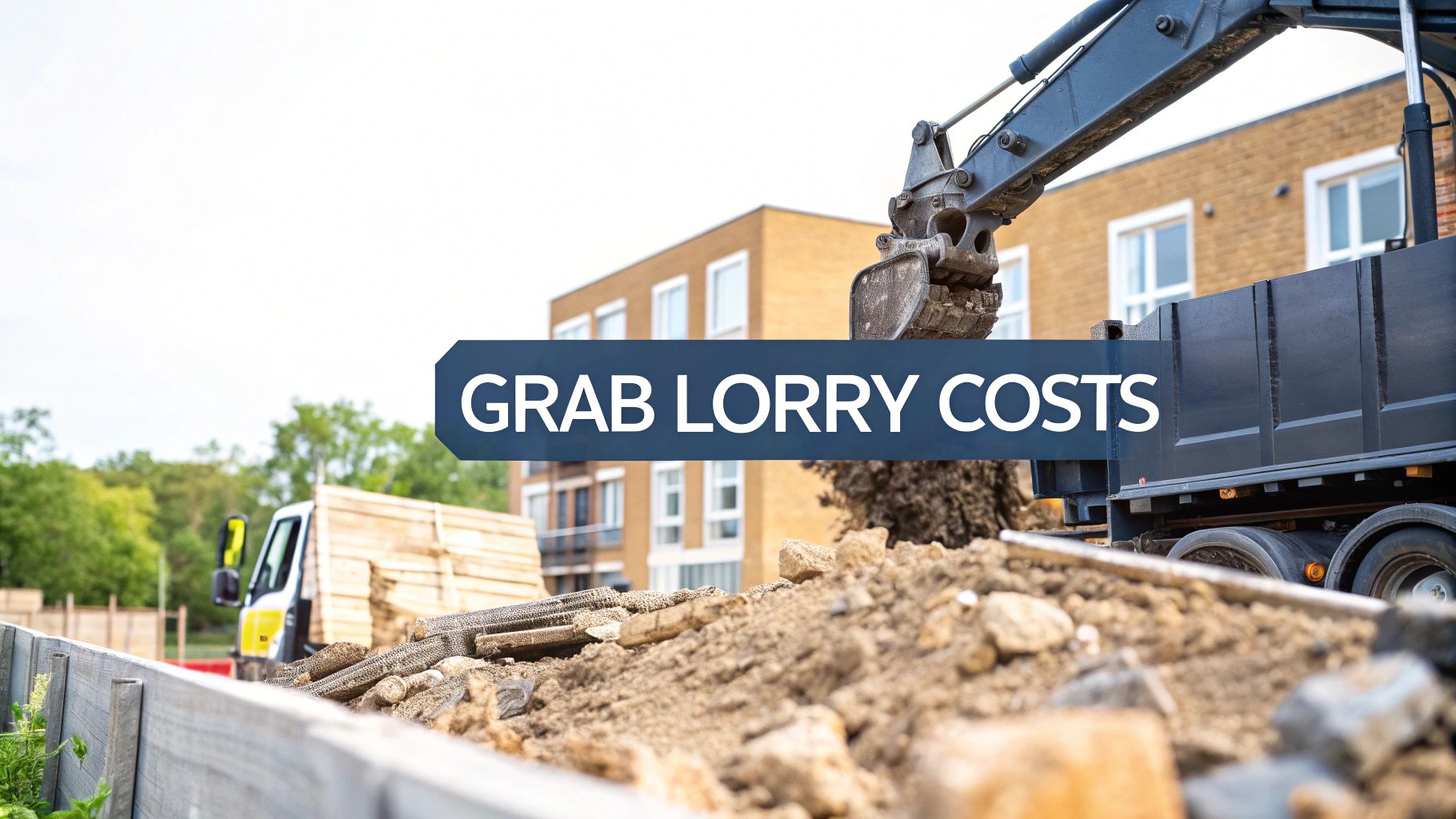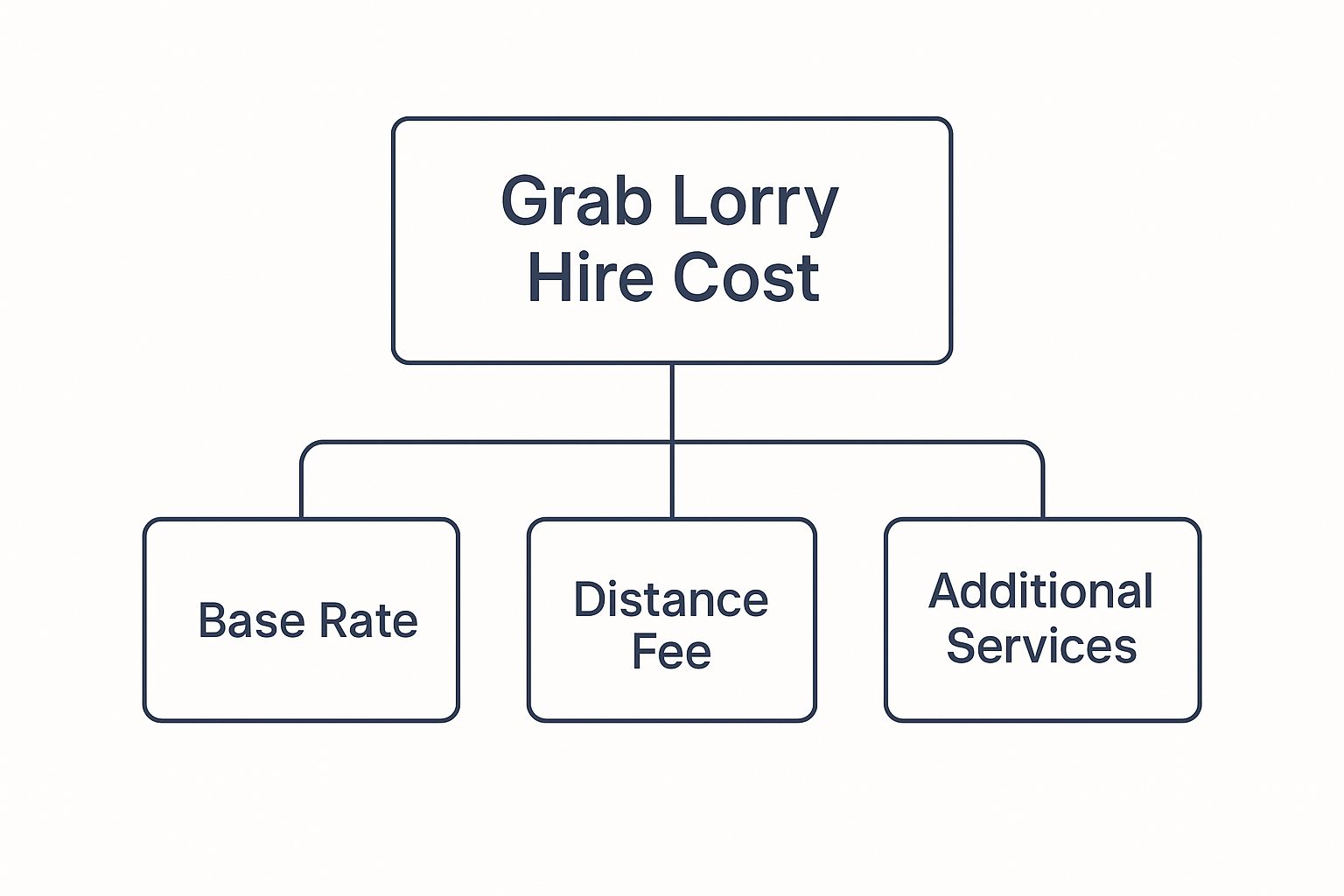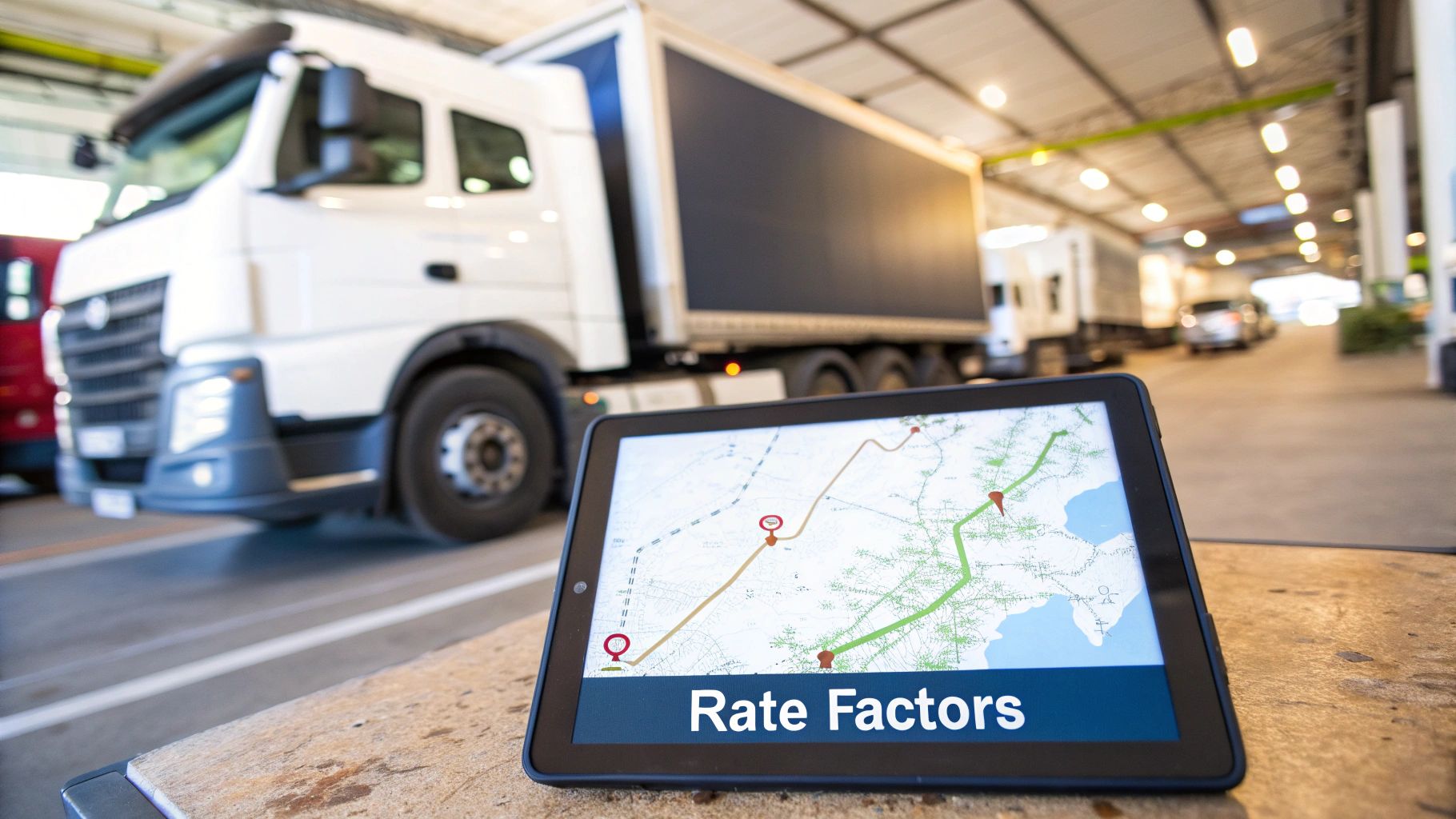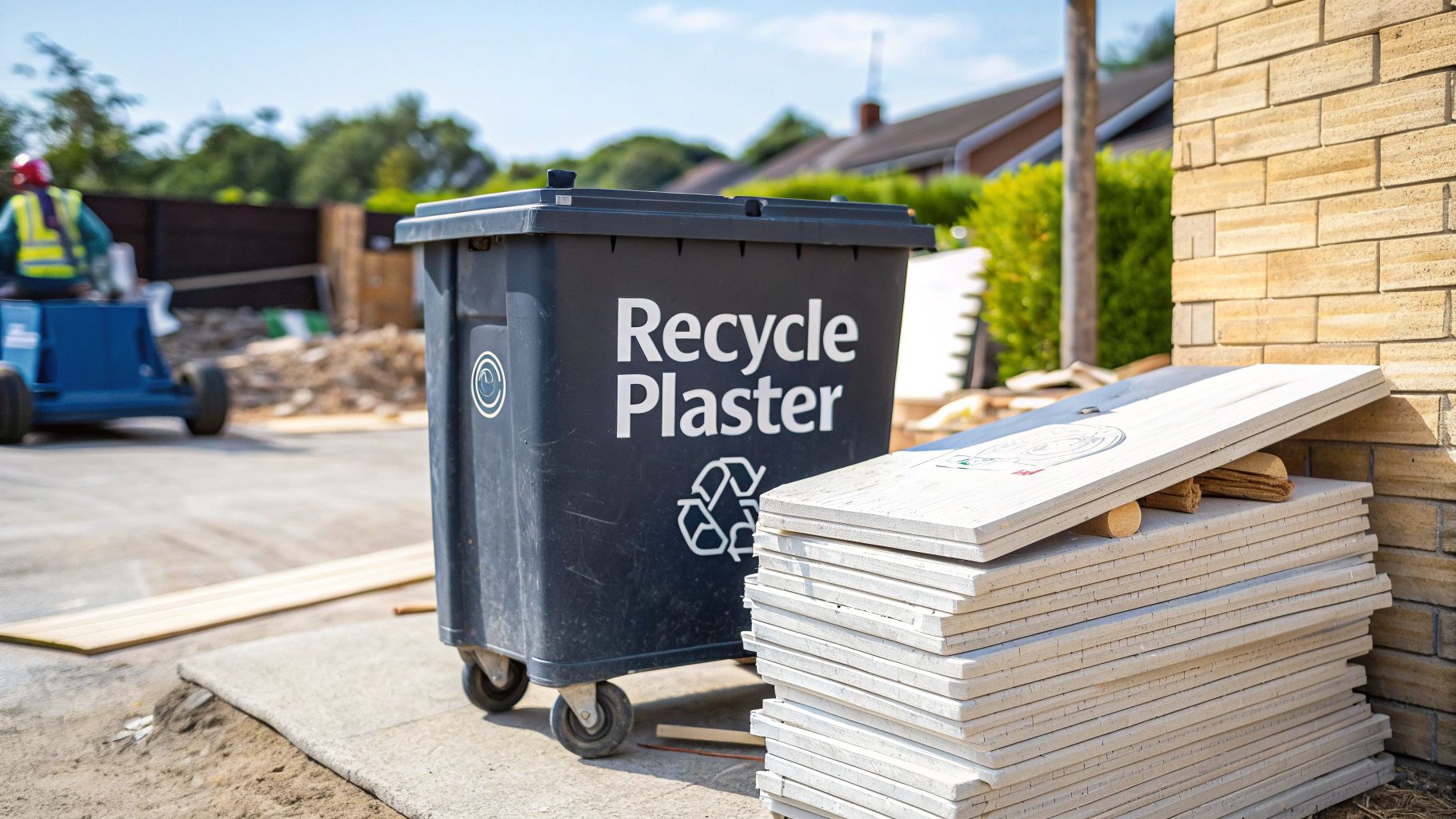Your Guide to Grab Lorry Hire Cost in the UK

Your Guide to Grab Lorry Hire Cost in the UK
When you’re trying to budget for a project, one of the first questions you’ll likely ask is, “How much is a grab lorry going to cost?”
Across the UK, the typical price for a single load sits somewhere between £150 and £420. Think of it a bit like ordering a taxi—the final bill depends on the size of the vehicle you need, how far it has to travel, and what kind of waste you’re asking it to haul away.
Your Guide to Grab Lorry Prices

Getting a handle on the numbers is the best way to plan your project budget properly. Unlike a simple off-the-shelf service, several factors can shift the price up or down, so it’s smart to have a clear picture from the start.
To help you out, here’s a quick look at the typical price ranges you can expect for different lorry sizes.
Typical Grab Lorry Hire Costs Per Load (Excluding VAT)
This table provides estimated price ranges for hiring different sizes of grab lorries across the UK, helping you quickly assess potential costs.
| Lorry Size | Typical Capacity (Tonnes) | Average Cost Range Per Load |
|---|---|---|
| 4-Wheeler | 7–9 Tonnes | £150 – £380 |
| 6-Wheeler | 11–13 Tonnes | £190 – £400 |
| 8-Wheeler | 14–16 Tonnes | £260 – £420 |
These figures are a great starting point for your budget. Keep in mind that your final quote can change based on your exact location, the type of waste you’re getting rid of, and the total weight of the load.
For instance, a standard 4-wheeler grab lorry is perfect for smaller jobs, carrying about 7 to 9 tonnes. On average, you can expect to pay around £275 per load (excluding VAT) for this size.
One of the biggest perks of using a grab lorry is just how efficient it is. The truck rolls up, its hydraulic crane loads all your waste in as little as 20-30 minutes, and then it’s gone. This seriously cuts down on disruption and often means you don’t even need a road permit, which can be a real cost-saver.
Of course, the price per load is tied directly to how much the lorry can carry. To get a better feel for this, it’s worth checking out our detailed guide on how much a grab lorry can take. Nailing the size choice is key—it stops you from overpaying for a lorry that’s too big or, even worse, having to book a second trip.
What Really Drives Your Final Quote
Knowing the baseline cost for a grab lorry is one thing, but what makes a quote jump from £200 to over £400? Several key factors come into play, and understanding them helps you budget better and even spot ways to save a bit of cash. It’s a bit like booking a flight – the destination is the same, but the final price depends on whether you’ve got extra bags, picked a specific seat, or are flying on a bank holiday.
In the same way, your grab hire quote is a mix of a few core variables. The main ones are the size of the lorry you need, the type of waste you’re getting rid of, and where you’re located. Each of these plays a big part in the total cost, and a change in one can easily affect the others.
This image breaks down the main things that add up to your final grab hire price.

As you can see, the final price isn’t just a single figure. It’s a combination of the base hire rate, any travel fees, and extra services your particular job might need.
Lorry Size and Capacity
The most straightforward factor is the size of the grab lorry itself. An 8-wheeler can haul away a lot more waste than a 4-wheeler, but it naturally comes with a higher price tag. The trick is to match the lorry to the size of your job.
It’s a classic balancing act. Hiring a lorry that’s too small might look cheaper at first, but you could end up paying for a second trip. On the other hand, ordering a huge 8-wheeler for a small garden tidy-up means you’re paying for space you don’t need. Getting the size right is the first and best way to keep costs down.
Waste Type and Disposal Fees
What you’re throwing away matters – a lot. The costs for disposing of different materials can vary massively because of recycling processes and landfill taxes.
- Inert Waste: This is your cheapest category. Think clean soil, clay, bricks, and concrete. It’s heavy, but it’s simple to recycle into new aggregates.
- Green Waste: Garden clippings like branches, leaves, and grass are also fairly inexpensive to handle, as they can be composted.
- Mixed Construction Waste: This is usually the priciest. A load jumbled up with wood, plastic, metal, and rubble has to be painstakingly sorted at a waste transfer station, which bumps up the labour and processing costs.
Here’s a key takeaway: a load of clean, separated hardcore will almost always be cheaper to shift than a mixed load of the same weight. Taking a bit of time to separate your waste on-site before the grab lorry arrives is a brilliant way to cut your final bill.
Your Location and Accessibility
Where your site is based can create a bit of a “postcode lottery” for hire prices. Running costs for fuel, staff, and depots are simply higher in big cities like London and across the South East. A grab hire service in a busy urban area is bound to cost more than the same service out in the sticks.
How easy it is to get to your site also has an impact. If the lorry has to squeeze down narrow lanes or the waste pile is in an awkward spot, it adds time and hassle to the job. This can sometimes be reflected in the quote.
For a more detailed look at how these costs stack up against other options, our article exploring if grab or skip hire is cheaper offers some great insights. By getting to grips with these factors, you’ll be in a much better position to predict your costs and make the right call for your project.
Choosing the Right Lorry for Your Project

Picking the right grab lorry for your job is one of the most important decisions you’ll make, and it has a direct impact on the overall grab lorry hire cost. Think of it like hiring a moving van. If you get one that’s too small, you’re stuck making extra, costly trips. Go too big, and you’re just paying for space you don’t need.
The trick is finding that perfect sweet spot where efficiency and cost-effectiveness meet. To get there, you need to match the lorry’s size to what your project actually demands. Each one is built for a different kind of job, from clearing out a tight urban garden to a massive commercial muck away.
The Agile 4-Wheeler
The 4-wheel grab lorry is the smallest and most nimble option out there. Its compact frame is a lifesaver for projects with tricky access – think residential driveways in built-up areas or narrow site entrances where a bigger truck just won’t squeeze through.
This lorry is your best bet for:
- Small domestic jobs like garden clearances or driveway digs.
- Projects producing a modest amount of waste, usually up to 9 tonnes.
- Any situation where easy manoeuvrability is your number one priority.
Its lower per-load price is tempting, but just remember its smaller capacity means it’s not the right tool for larger clear-outs.
The Versatile 6-Wheeler
The 6-wheel grab lorry is the true all-rounder of the industry, hitting a fantastic sweet spot between capacity and accessibility. It can shift a decent amount of waste without needing the huge access space that the giant 8-wheelers demand, which is why it’s such a popular choice for all sorts of medium-sized projects.
This flexibility makes it the go-to workhorse for countless builders and landscapers on their day-to-day jobs.
A 6-wheel grab lorry typically holds around 12 cubic metres of inert waste (soil, bricks, hardcore), which is roughly 11 to 13 tonnes. It’s crucial to think about both volume and weight, as charges are usually per load but can be affected by tonnage for certain types of waste. You can always get more specific details on grab lorry capacities from waste removal specialists.
The Powerful 8-Wheeler
When you’re tackling the big stuff – major site clearances, large-scale excavations, or commercial construction projects – the 8-wheel grab lorry is the undisputed heavyweight champion. It’s built for one thing: maximum capacity. This beast can remove enormous volumes of waste in a single trip.
This powerhouse is easily the most cost-effective option for jobs that generate a serious amount of heavy material. An 8-wheeler can carry about 15 cubic metres, which translates to a hefty 14 to 16 tonnes of waste. By opting for this lorry on a big project, you slash the number of collections needed.
That means less money spent on labour, lower fuel consumption, and less disruption on your site. That kind of efficiency is exactly how you keep a project on budget.
How Waste Type and Weight Affect Pricing

When it comes to the final grab lorry hire cost, what you’re getting rid of is just as important as how much of it there is. Not all waste carries the same price tag, and understanding why can unlock some serious savings on your project.
Think of it like posting a parcel. A simple letter costs very little, but sending a heavy, fragile, or awkwardly shaped package requires special handling and costs a good bit more. Waste disposal works on a similar principle. The simple truth is that disposal fees, which vary wildly between materials, are a huge chunk of your final bill.
Understanding the Waste Hierarchy
So, why the different prices? It all boils down to two things: how much the disposal facility charges and the sheer weight of the load. Certain materials can be recycled cheaply into new products, while others need complex sorting or get hit with higher landfill taxes. This creates a clear cost structure.
Inert waste, for instance, is the most straightforward and, you guessed it, the cheapest to dispose of. This category includes materials that don’t decompose or react chemically.
- Inert Waste: This is your clean soil, clay, concrete, bricks, and rubble. These are easily crushed and recycled into aggregates for new construction projects.
- Green Waste: We’re talking garden materials like branches, leaves, and grass. This can be composted, which makes it relatively low-cost to process.
- Mixed Construction Waste: Now we’re getting expensive. A jumble of wood, plasterboard, plastics, and metal has to be manually and mechanically sorted at a waste transfer station before it goes anywhere.
The logic is simple. The more work required to sort and process the waste, the higher the disposal fee passed on to you.
It’s helpful to see how these categories stack up against each other in terms of cost.
Cost Impact of Different Waste Types
| Waste Category | Description | Relative Cost Impact |
|---|---|---|
| Inert Waste | Soil, hardcore, rubble, concrete, bricks. Clean and easily recycled. | Low |
| Green Waste | Garden clippings, branches, leaves, turf. Can be composted. | Low to Medium |
| Clean Timber | Untreated wood, pallets, and offcuts. Can be chipped and reused. | Medium |
| Mixed General | A mix of light household or commercial items like furniture or packaging. | Medium to High |
| Mixed Construction | A combination of wood, metal, plastic, plasterboard, etc. Requires sorting. | High |
As you can see, keeping your inert waste separate from your mixed construction materials can make a real difference to your invoice.
Why Weight Directly Influences Your Quote
Beyond the type of material, its sheer weight plays a massive role. Heavier loads mean the grab lorry burns more fuel, and most disposal sites charge by the tonne. This direct link between weight and cost is a fundamental part of pricing.
The numbers back this up. For lighter loads up to 4 tonnes, you can expect to pay around £150 to £200. This climbs to between £220 and £300 for mid-sized loads of 5 to 8 tonnes. For the really heavy stuff, 9 to 12 tonnes, hire fees typically sit between £320 and £400. You can find more detailed price breakdowns by exploring the latest grabber lorry cost guides.
Pro Tip: The smartest way to reduce your grab lorry hire cost is to segregate your waste on-site. By creating separate piles for soil, hardcore, and general mixed waste, you can often pay the lower rate for the inert materials. It’s a simple step that can make a substantial difference to your final bill.
Honestly, just organising your waste before the lorry arrives is one of the most effective cost-saving moves you can make.
Practical Ways to Reduce Your Hire Costs
Knowing what factors drive the grab lorry hire cost is one thing, but actually putting that knowledge to use is how you’ll save real money. With a bit of smart planning, you can make a serious dent in your final bill without cutting any corners on service.
It’s all about thinking ahead and making the collection as smooth as possible for the hire company.
Think of it like getting ready for a removals firm. If you’ve got everything boxed up, labelled, and stacked by the front door, their job is quicker, easier, and often cheaper. The same logic applies here. A little prep work on your part pays dividends.
Be Strategic with Your Waste
The single best thing you can do to lower your costs is to manage your waste before the lorry turns up. As we’ve covered, different materials come with different disposal fees, and clean, inert waste is always the cheapest to get rid of.
- Segregate Your Materials: Make separate piles for soil, hardcore (like bricks and concrete), and any general mixed waste. This simple step stops you from paying the higher mixed-waste rate for the whole lot.
- Stockpile Correctly: Keep your waste in one easy-to-reach spot, ideally within the crane’s reach (that’s usually 7-8 metres from the road). This allows for a fast, single-point collection.
- Avoid Contamination: Be strict about keeping things like plasterboard, wood, and plastics out of your soil or hardcore piles. Just a small amount of the wrong material can get the entire load reclassified as more expensive mixed waste.
A well-organised site is a cost-effective site. By making sure the lorry can pull up, load up, and drive off without any hassle, you sidestep any potential waiting charges that some companies apply if a collection takes longer than the standard 20-30 minutes.
Plan Your Hire Like a Pro
Beyond just sorting the muck, a few logistical moves can make a huge difference to your wallet. Don’t just book the first company you find online; a bit of legwork really does pay off.
First up, always get multiple quotes from local grab hire firms. Prices can vary quite a bit, even between companies in the same town. Getting at least three quotes gives you a solid benchmark for the going rate and a much better footing if you need to negotiate.
Next, be accurate with your volume estimate. If you’re on the fence, it’s often smarter to slightly overestimate and book a bigger lorry. It might feel backwards, but hiring an 8-wheeler that clears everything in one trip is almost always cheaper than booking a 6-wheeler only to realise you need a second collection for what’s left over.
Finally, think about how your approach benefits both your budget and the planet. Good waste management is a key part of modern, green building. By sorting your waste, you’re not just saving a few quid – you’re making it easier to recycle and keeping more material out of landfill. You can learn more about the role of waste management in sustainable construction projects to see how it all fits together.
Got Questions About Grab Lorry Hire? We’ve Got Answers
When you’re thinking about hiring a grab lorry, a few practical questions always pop up. Getting them answered properly can be the difference between a project running like clockwork and one that’s just a headache. It’s all about budgeting correctly and making sure there are no nasty surprises on the day.
Let’s dive into some of the most common queries we get, covering everything from permits to how far that crane can actually reach. Getting your head around these details will help you plan with confidence and make your waste removal as smooth as possible.
Do I Need a Permit for a Grab Lorry?
This is one of the best bits about grab hire: in most situations, you do not need a permit. This is a massive plus when you compare it to hiring a skip, where you’re legally required to get a permit from the council if it’s going on any public land, like a pavement or the road itself.
A grab lorry is a quick-in, quick-out solution. It pulls up, grabs the waste, and is usually gone in less than 30 minutes. Because it doesn’t hang around occupying public space, the need for a permit is eliminated. The only catch is that your waste needs to be stockpiled on your private property—think your driveway or front garden—where the crane can easily get to it from the road. It’s this efficiency that makes it so handy and keeps the costs down.
How Far Can a Grab Lorry Crane Reach?
Knowing the reach of the hydraulic crane is a game-changer when you’re planning your site. Most of the standard 8-wheeler grab lorries you’ll see are fitted with a crane that can stretch out to about 7 to 8 metres.
That’s a pretty impressive range, and it means the operator can collect waste from spots that might otherwise seem impossible to get to. For instance, the crane can easily reach over fences, garden walls, or hedges to scoop up a pile of waste while the lorry stays parked neatly on the street. When you’re making your pile, just be sure it’s within that distance from where the lorry can safely park. It’s always a good idea to double-check the specific lorry’s reach with your hire company, just to be certain.
A bit of planning here goes a long way. A well-placed pile of waste, clear of any overhead trees or cables and within the crane’s reach, means the collection will be incredibly quick. This speed is a huge part of what keeps the overall grab lorry hire cost so competitive.
What Is the Difference Between Grab Hire and Muck Away?
You’ll often hear these two terms used as if they’re the same thing, but there’s a small but important difference.
- Grab Hire is the big-picture term. It simply refers to hiring the vehicle for a job. This could be for removing all sorts of waste, or even for delivering materials like sand and gravel to your site.
- Muck Away is more specific. It’s the term for removing inert waste from building and digging projects. We’re talking about things like soil, clay, hardcore, and rubble.
So, really, muck away is just one type of grab hire service. When you ask for a “muck away” service, you’re telling the company exactly what you need shifting—inert spoil. This clarity often helps them give you a more accurate, and usually cheaper, quote.
Can a Grab Lorry Take Mixed Waste?
Yes, it absolutely can. Most grab hire companies are more than happy to collect mixed loads of waste. This might be a combination of soil, bricks, concrete, wood, metal, and other general rubbish from a building or renovation job.
It’s crucial to know, though, that a mixed load will nearly always cost more to get rid of than a load of a single material like soil or hardcore. The extra cost comes from the work needed to sort everything out at the waste station. If you want to keep your grab lorry hire cost as low as possible, your best bet is always to separate your waste on-site before it gets collected.
At The Waste Group, we believe in clear, upfront pricing and giving you the expert advice you need. We want to make sure you get the most efficient and affordable waste solution for your project. Whether you need a muck away service for a pile of soil or a collection for mixed construction waste, our experienced team is ready to help. Get a fast, no-obligation quote online today by visiting us at https://www.thewastegroup.co.uk.

